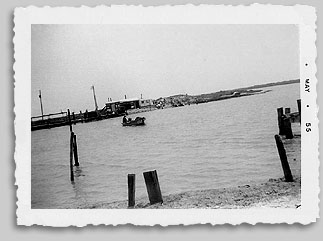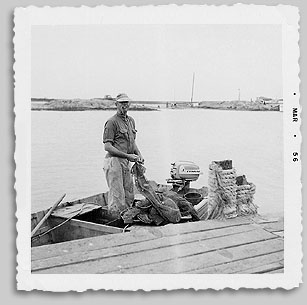1911
Born October 5, Bay City, Texas, the first child of Arnold and Minta Bess. Spends early childhood in Clemville, Texas; travels with family to oil boomtowns throughout Texas and Oklahoma.
1915
On Easter morning experiences first vision: a Dutch village guarded by a lion and a tiger.
1918
Executes first drawings, copied from encyclopedia.
1924
Takes private painting lessons from a neighbor in Corsicana, Texas.
1929
Enters Texas A&M University in architecture department, but has great difficulty with physics, math, and engineering requirements. Becomes interested in descriptive geometry, English literature, Hinduism, and Greek mythology, as well as the works of Darwin and Freud.
Continues to paint.
1931
Transfers to University of Texas; develops friendship with Professor Sam Gideon, who encourages his study of religion.
Repeatedly reads Havelock Ellis' Psychology of Sex; learns of aborigine rituals.
1933
Leaves school. Works as roughneck in oil fields to earn money for first of several trips to Mexico.
1934
Returns from Mexico and sets up small studio in Bay City, Texas. Paints portraits, houses, and dogs in what he identifies as a Post-Impressionist manner similar to that of Vincent Van Gogh and Maurice Vlaminck. Begins "visionary paintings" executed directly from sketches based on his dream imagery. Works receive negative response in Bay City.
1936
First exhibition, in a hotel lobby in Bay City.
1938
One-man exhibition at the Witte Memorial Museum, San Antonio, Texas; included in group show at the Houston Museum of Fine Arts.
 1939
1939
A painting included in Corcoran Gallery Biennial.
1941-1945
Military service with Army Corps of Engineers; develops camouflage plans for which he receives commendation.
1946
While still in the Army, suffers mental breakdown; has hallucinations of "The Bug" and the "Little Puffball of Love," images which he later executes as paintings.
Psychiatrist at Veterans Administration hospital gives him first inkling of possible significance of the colored patterns he sees before falling asleep.
First appearance of recognizable symbols in his work.
Transfers from Army Corps of Engineers to a job teaching painting in the Veterans Administration hospital, San Antonio—"a great relief from army life."
1947
Returns to Bay City. Sets up commercial fishing and bait camp on Chinquapin Bay on the Intracoastal Waterway. Makes extra money building frames, designing visual aids for the public school, and giving private painting lessons.
Subject matter of painting drawn exclusively from visions.
1948
Sells early paintings for ten dollars apiece to go to New York to see Betty Parsons.
1949
Joins Betty Parsons Gallery; first show there in December.
Spends fall with Rosalie and Sidney Berkowitz in Woodstock, New York, while waiting for opening of Parsons exhibition.
Begins extensive correspondence with Betty Parsons; outlines two conflicting tendencies in his personality—the "practical-sensible-aggressive" side, and the "artistic-sensitive-introspective" one.
1950
Contacts Jung about his ideas on symbolism and psychology. Jung responds that Bess' ideas are not unique, but "are rediscovered every century."
Application for Guggenheim Fellowship rejected.
1951
One-man show at the Museum of Fine Arts, Houston, in April. In conjunction with exhibition, writes series of articles on art and architecture for the Daily Tribune in Bay City.
Works on idea for an abstract ballet.
Betty Parsons considers publishing Bess' letters; later rejects idea.
One-man shows at Texas A&M Student Center, and at the Oklahoma Art Center, Oklahoma City.
 1952
1952
Included in four-man show at Philbrook Art Center, Tulsa, Oklahoma, in February.
1953
Completes plan for Ballet Black and White; submits it to Meyer Schapiro, who dismisses it.
Continues correspondence with psychology and anthropology scholars about his theories.
1954
One-man show at Betty Parsons Gallery.
Father dies; mother eventually moves to Bay City.
Concludes that the hermaphrodite is the universal symbol found in Egyptian, Hebrew, Greek, and Chinese art.
1955
Lectures at the Medical Center, Galveston, on "The Use of Symbols to Release Tensions."
1956
Begins collecting written data on relation between endocrinology and painting.
1957
One-man show at Betty Parsons Gallery.
1958
Compiles notebook of sketches, clippings, and quotations—drawn from alchemy, mythology, art history, iconography, psychoanalysis, Jungian mysticism, Goethe, the Bible, and personal experience—to support his thesis that the key to eternal life is the urethral orgasm of the pseudo-hermaphrodite.
One-man exhibitions at André Emmerich Gallery, Houston; Stanford University, Palo Alto, California; included in group show at the M.H. de Young Memorial Museum, San Francisco.
 1959
1959
Submits notebook to Ford Foundation as project for possible research funding; also circulates it to scholars across the country for comments.
One-man show at Betty Parsons Gallery in April.
1960
Undergoes first of a series of surgical operations to support his immortality thesis.
1961
Develops idea for a film based on vision of Dionysius as both bull and man; seeks funding for this project from several patrons.
Hurricane Carla hits Gulf Coast; Bess loses his house and possessions, but salvages paintings.
1962
Retrospective at Betty Parsons Gallery in January; catalogue includes essay by Meyer Schapiro.
One-man show at Contemporary Arts Museum, Houston, in April.
Painting included in "Wit and Whimsy in 20th Century Art," organized by the American Federation of Arts, New York.
1963
Blaffer Foundation considers doing a monograph on his work; later abandons project.
One-man exhibition at the New Arts Gallery, Houston, in May.
1965
Dr. John Money at John Hopkins University becomes interested in Bess' ideas; later includes him in an article, written in conjunction with Michael DiPriest, for Journal of Sex Research, 1976.
Bess' notebook documenting his immortality thesis read by some faculty members at University of California, Los Angeles, School of Medicine, and by anthropologists at the University of Western Australia studying aborigine tribes whose rituals include pseudo-hermaphroditic alteration.
Enters what he identifies as "Phase Two" of his career—more highly defined symbolism and expansion of media to include sculpture and film.
1966
Work included in the Eighth Annual Painting Invitational sponsored by the Junior League of Longview, Texas.
1967
Last one-man show at Betty Parsons Gallery in May.
One-man show at the Witte Memorial Museum, San Antonio, in October.
1968
Medical editor of Washington Star loses the documentary notebook Bess had been compiling since 1958.
1973
Meyer Schapiro assists in getting Bess a Mark Rothko Foundation grant for $125 a month.
1974
Suffers mild stroke. Brother commits him to San Antonio State Hospital in May. Enters Bay Villa Nursing Home, Bay City, in September; ceases to paint.
1977
One-man show sponsored by Bay City Art League in March.
Dies November 11 in Bay Villa Nursing Home.

 1911
1911 1939
1939 1952
1952 1959
1959